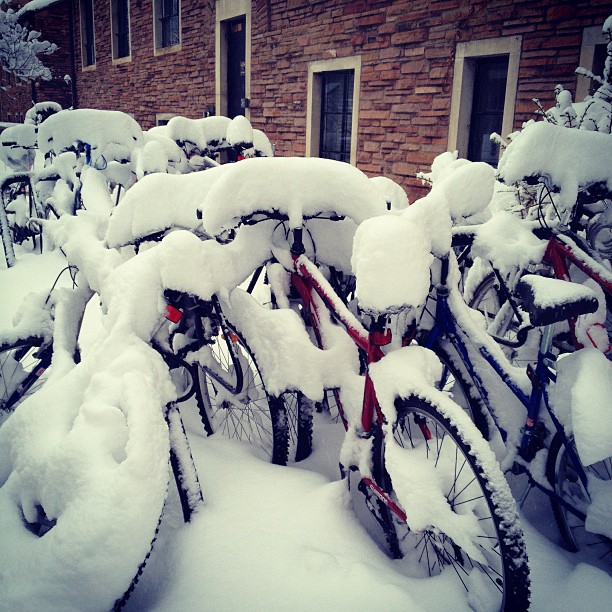
Kara BrugmanMay snow in Boulder, Colo.
It was high time to pass around a few cold ones in the shade of an awning in Amarillo, Texas, just a few days ago. Now it’s time to hunker inside, drink whiskey neat, and play charades.
The city broke a heat record on April 30, reaching a scorching hot 97 degrees. Then it got hit by unseasonably cold weather that has swept through the nation’s heartland. A couple days after reaching 97, the temperature bottomed out at 33 degrees, with the cold snap bringing some snow.
The topsy-turvy weather in Amarillo is emblematic of the climatic incoherence reigning across the country. The coasts are basking in spring weather while the Rockies, Great Plains, and Midwest are being smacked by snow storms.
The unseasonably late chill appears to be one of many symptoms of the changing climate. But before we dive into that, let’s take a look at the extraordinary weather pummeling the Midwest. From The Weather Channel:
Winter Storm Achilles may have set the record for the biggest May snowstorm at any single location in four different states! That said, these potential records are based on preliminary data and will have to be verified.
Wisconsin — We’ve seen snowfall reports of 18 inches near Hayward and 17 inches in Rice Lake. …
Minnesota — 18 inches of snow was measured in Blooming Prairie, between Albert Lea and Rochester. …
Iowa — 13 inches of snow has been measured by an observer in Osage. …
Arkansas — Up to 3.5 inches reported in Gravette.
The notion that global warming could trigger cold weather is enough to make a conservative pundit’s head explode. Science is hard!
But Minnesota Public Radio asked a meteorologist about possible links between the late-season snowstorms and climate change. While issuing the standard caveats about how climate change doesn’t “cause” any particular weather events, he explained some likely connections. Here’s a partial transcript of the the exchange during the radio station’s weekly Climate Cast program:
[Host Kerri] Miller: I think this late spring snow is a good opportunity to ask again as we have during our Climate Cast — weather or climate? How do we answer that?
[Meteorologist Paul] Huttner: What’s happening today is weather, there’s no doubt about it. This is a very out-of-season event. All weather in a way seems to be colored or flavored by the climate changes we’re seeing. If you’re going to tie a link to today’s weather to climate change you would have to cite Arctic amplification. We’ve touched on that before. That’s where this slower jet stream gets stuck. It slows down and these blocking patterns set up and our weather patterns get stuck. That’s what’s been happening a lot in Minnesota and the Upper Midwest this spring. Some links that this may be tied to the warmer Arctic Ocean that we saw last summer. It’s not a slam dunk, but the clues all seem to be pointing in the same direction. …
We’re seeing a trend where the atmosphere overall holds about four to five percent more water vapor than it did a decade ago, and that injects these storms with more moisture.
The other thing about this storm and drawing a parallel with Hurricane Sandy late last fall, it’s a little bit out of season. In fact, this is well out of season for Minnesota. It’s unprecedented, the amount of snowfall we’ve had today in Minnesota. Mark Seeley tells me that Dodge Center, with 15.4 inches of snow, broke the all-time state snowfall record for May 2 today. This is definitely an unprecedented out-of-season event. When you get these events in May, when we’ve still got cold enough air for snow but we’ve got so much warmth and moisture to the south, it just supercharges these storms and that can tend to produce more precipitation than an atmosphere with less water in it.
Schoolkids in Minnesota and Wisconsin got a rare May snow day on Thursday, while lucky students at one school in the Seattle area got a “sun day” on Friday to celebrate unusually warm and sunny weather.



